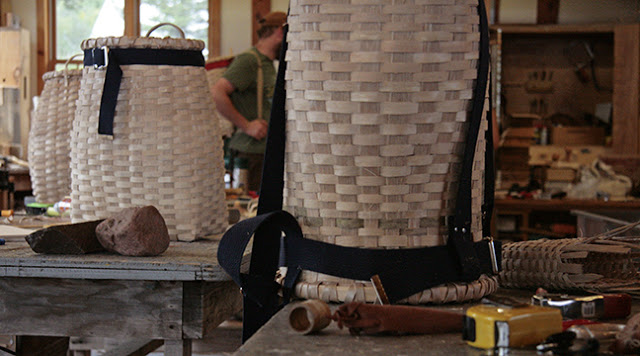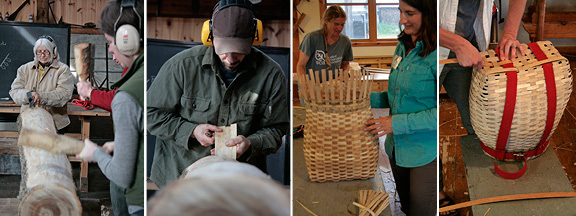
Harvesting a Tree to Weave into a Backpack

Another batch of Black Ash Pack Basket makers hatched this summer, thanks to Instructor Ian Andrus. A past intern at North House and a current instructor of many classes, Ian teaches this class at least twice a year, and it always fills up. As a student of that class, I could tell Ian was a seasoned instructor who had sorted out kinks of teaching the class a while ago. He was always a step ahead of us, ready to demonstrate the next phase to us as a group or as inpiduals.
A neat aspect of this class is that students work to prepare the materials from a log into a basket, rather than the instructor prepping all of the material so that students show up and only experience weaving. Over the course of three days, students phased from pounding hardwood mallets on bare black ash tree logs and peeling strips of growth rings on the first day, to scraping and cutting the splint to weaving size on the first and second days, and finally, weaving the basket on days two and three.
The missing step is harvesting the black ash tree. Prior to the class, I seized the opportunity to go into the woods with Ian to select and haul out a few black ash trees on a friend's private property. We searched for a straight tree with a healthy crown and a 6-8' section with few to no branches. Then we used a tree core borer to check out the thickness of the growth rings (which become the splint you peel, cut, and weave). Without a tree core borer, an alternative is to chip away a very small section to sneak a peek inside the bark. Both methods, when done correctly, do not harm the tree.
When we found the tree, Ian used a chainsaw to fell the tree and cut it into logs. We hoisted it onto shoulders and hiked back to the truck. In between harvesting and the class, the logs are tied up with a rope to the North House dock and they float and stay fresh in Lake Superior. At the end of the class, plenty of splint remained for future basket projects. Perhaps some of the students will share the skills they learned so that another batch of black ash pack basket makers will hatch.
